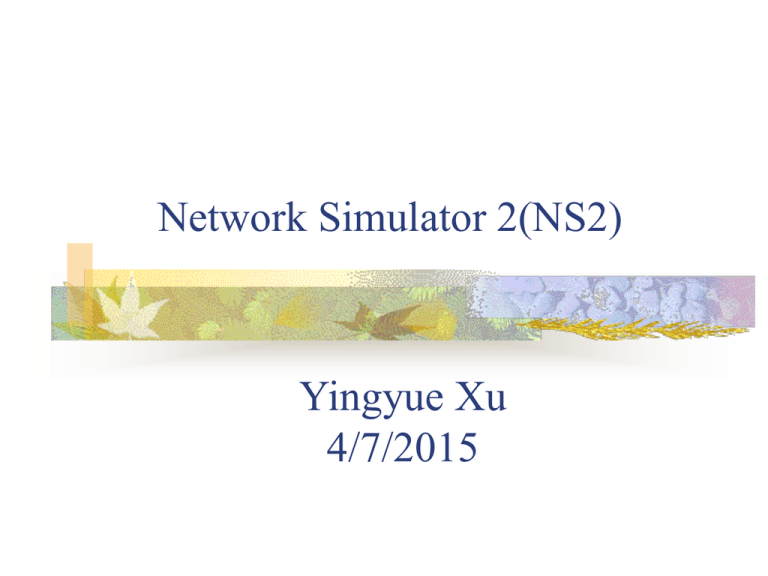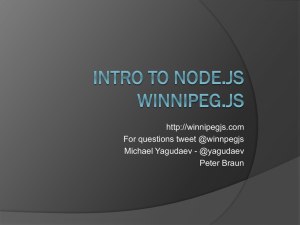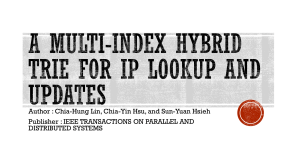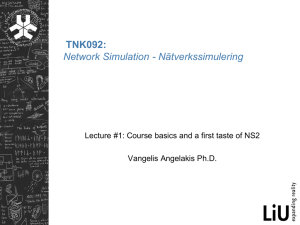Create network
advertisement

Network Simulator 2(NS2)
Yingyue Xu
4/7/2015
Overview:
The Network simulator (NS):
discrete event simulator for networks.
supports wired, wireless, and satellite networks.
various routing and multicast protocols.
written in C++ and object-oriented tool command
language (OTcl).
NS output is a file(s) which contains all packet
information. It can be viewed using network animator
(NAM), xgraph, or processed with custom scripts (Perl,
Tcl or Awk ).
User view of NS:
Why two languages:
C++
Fast in running.
Slow and hard to modify (need
to recompile the whole NS ).
Used to implement detailed
protocols and algorithms, to
manipulate bytes since it can run
over large number of data
OTcl
Slow in running
Can be quickly changed (no
need to recompile).
Used to implement the
simulation configuration like
# of nodes, simulation
topology and the dimensions
of test area.
That’s why NS object called split object!
NS via Tclcl (Tcl with classes) provides glue to make objects and
variables appear on both languages.
Ns functionalities
Wired world
Wireless
Routing DV, LS, PIM-SM
Transportation: TCP and UDP
Traffic sources:web, ftp, telnet, cbr, stochastic
Queuing disciplines:drop-tail, RED, FQ, SFQ, DRR
QoS: IntServ and Diffserv
Emulation
Ad hoc routing and mobile IP
Directed diffusion, sensor-MAC
Tracing, visualization, various utilities
Ns Models
Traffic models and applications:
Transport protocols:
unicast: TCP (Reno, Vegas, etc.), UDP
Multicast: SRM
Routing and queueing:
Web, FTP, telnet, constant-bit rate, real audio
Wired routing, ad hoc rtg and directed diffusion
queueing protocols: RED, drop-tail, etc
Physical media:
Wired (point-to-point, LANs), wireless (multiple
propagation models), satellite
NS installation:
NS can work on most UNIX platforms, and
also on windows platform.
Detailed info for downloading and building NS:
http://www.isi.edu/nsnam/ns/ns-build.html
Easier way to download all in one package
and build NS (this will not work on
Windows), this package contains Tcl, Tclcl,
OTcl, Tk, and NS source codes.
You need to run install from UNIX shell
(Bash or C shell).
Basic Tcl
variables:
set x 10
puts “x is $x”
functions and expressions:
set y [pow x 2]
set y [expr x*x]
control flow:
if {$x > 0} { return $x } else {
return [expr -$x] }
while { $x > 0 } {
puts $x
incr x –1
}
procedures:
proc pow {x n} {
if {$n == 1} { return $x }
set part [pow x [expr $n-1]]
return [expr $x*$part]
}
Also lists, associative arrays,
etc.
=> can use a real
programming language to
build network topologies,
traffic models, etc.
Basic otcl
Class Person
# constructor:
Person instproc init {age} {
$self instvar age_
set age_ $age
}
# method:
Person instproc greet {} {
$self instvar age_
puts “$age_ years old: How
are you doing?”
}
# subclass:
Class Kid -superclass Person
Kid instproc greet {} {
$self instvar age_
puts “$age_ years old kid:
What’s up, dude?”
}
set a [new Person 45]
set b [new Kid 15]
$a greet
$b greet
=> can easily make variations of existing things (TCP, TCP/Reno)
Ns programming
Create the event scheduler
Turn on tracing
Create network
Setup routing
Insert errors
Create transport connection
Create traffic
Transmit application-level data
Creating Event Scheduler
Create event scheduler
set ns [new Simulator]
Schedule events
$ns at <time> <event>
<event>: any legitimate ns/tcl commands
$ns at 5.0 “finish”
Start scheduler
$ns run
Ns programming
Create the event scheduler
Turn on tracing
Create network
Setup routing
Insert errors
Create transport connection
Create traffic
Transmit application-level data
Tracing and Monitoring
Packet
tracing:
On
all links: $ns trace-all [open out.tr w]
On one specific link: $ns trace-queue $n0
$n1$tr
<Event> <time> <from> <to> <pkt> <size> -- <fid> <src> <dst>
<seq> <attr>
+ 1 0 2 cbr 210 ------- 0 0.0 3.1 0 0
- 1 0 2 cbr 210 ------- 0 0.0 3.1 0 0
r 1.00234 0 2 cbr 210 ------- 0 0.0 3.1 0 0
Ns programming
Create the event scheduler
Turn on tracing
Create network
Setup routing
Insert errors
Create transport connection
Create traffic
Transmit application-level data
Creating Network
Nodes
set n0 [$ns node]
set n1 [$ns node]
Links and queuing
$ns <link_type> $n0 $n1 <bandwidth> <delay>
<queue_type>
<link_type>: duplex-link, simplex-link
<queue_type>: DropTail, RED, CBQ, FQ, SFQ,
DRR, diffserv RED queues
Creating Network: LAN
$ns make-lan <node_list> <bandwidth>
<delay> <ll_type> <ifq_type> <mac_type>
<channel_type>
<ll_type>: LL
<ifq_type>: Queue/DropTail,
<mac_type>: MAC/802_3
<channel_type>: Channel
Ns programming
Create the event scheduler
Turn on tracing
Create network
Setup routing
Insert errors
Create transport connection
Create traffic
Transmit application-level data
Setup Routing
Unicast
$ns rtproto <type>
<type>: Static, Session, DV, cost, multi-path
Multicast
$ns multicast (right after [new Simulator])
$ns mrtproto <type>
<type>: CtrMcast, DM, ST, BST
Other types of routing supported: source routing,
hierarchical routing
Ns programming
Create the event scheduler
Turn on tracing
Create network
Setup routing
Insert errors
Create transport connection
Create traffic
Transmit application-level data
Inserting Errors
Creating Error Module
set loss_module [new ErrorModel]
$loss_module set rate_ 0.01
$loss_module unit pkt
$loss_module ranvar [new RandomVariable/Uniform]
$loss_module drop-target [new Agent/Null]
Inserting Error Module
$ns lossmodel $loss_module $n0 $n1
Ns programming
Create the event scheduler
Turn on tracing
Create network
Setup routing
Insert errors
Create transport connection
Create traffic
Creating Connection and Traffic
UDP
CBR
set udp [new Agent/UDP] set src [new
set null [new Agent/Null]
Application/Traffic/CBR]
$ns attach-agent $n0
$udp
$ns attach-agent $n1
$null
$ns connect $udp $null
Creating Connection and Traffic II
TCP
set tcp [new Agent/TCP]
set tcpsink [new
Agent/TCPSink]
$ns attach-agent $n0 $tcp
$ns attach-agent $n1
$tcpsink
$ns connect $tcp $tcpsink
FTP
set ftp [new Application/FTP]
$ftp attach-agent $tcp
Telnet
set telnet [new
Application/Telnet]
$telnet attach-agent $tcp
Summary: Generic Script Structure
set ns [new Simulator]
# [Turn on tracing]
# Create topology
# Setup packet loss, link dynamics
# Create routing agents
# Create:
#
- multicast groups
#
- protocol agents
#
- application and/or setup traffic sources
# Post-processing procs
# Start simulation
Plumbing: Packet Flow
n0
n1
Port
Classifier
Addr
Classifier
entry_
0
1
0
Application/FTP
dst_=1.0
Port
Classifier
Addr
Classifier
Agent/TCP
Link n0-n1
entry_
Link n1-n0
1
0
0
dst_=0.0
Agent/TCPSink
Getting started with nam
Turn on nam tracing in your Tcl script
As easy as turning on normal tracing
$ns namtrace $file
Specify link orientation (or node position
for wireless)
$ns duplex-link-op $node1 $node2 orient left
Execute nam
exec nam $filename
Advanced nam capabilities
Node options — color, shape, label
$node
$node
$node
$node
$node
color red
shape hexagon
label “my text”
label-color blue
label-at up
Link options
$ns
$ns
$ns
$ns
$ns
duplex-link-op
duplex-link-op
duplex-link-op
duplex-link-op
duplex-link-op
$n1 $n2 color green
queuePos right
$n1 $n2 label “my text”
$n1 $n2 label-color blue
$n1 $n2 label-at down
Advanced nam capabilities
Packet colors
$ns color $n blue
$agent set fid_ $n
Annotation
$ns at $time “$ns trace-annotate $text”
Control playback
$ns set-animation-rate 3ms
The nam user interface
The nam editor
Create simple scenarios graphically
Good for those who don’t want to learn Tcl,
but only a limited subset of ns is available
The nam editor
Wireless model
Mobilenode at core of mobility model
Mobilenodes can move in a given topology,
receive/transmit signals from/to wireless channels
Wireless network stack consists of LL, ARP,
MAC, IFQ etc
Allows simulations of multi-hop ad hoc networks,
wireless LANs, sensor networks etc
An Example – Step 1
# Define Global Variables
# create simulator
set ns [new Simulator]
# create a flat topology in a 670m x 670m
area
set topo [new Topography]
$topo load_flatgrid 670 670
An Example – Step 2
# Define standard ns/nam trace
# ns trace
set tracefd
[open demo.tr w]
$ns trace-all $tracefd
# nam trace
set namtrace [open demo.nam w]
$ns namtrace-all-wireless $namtrace 670 670
GOD
(General Operations Director)
Stores smallest number of hops from one
node to another
Optimal case to compare routing protocol
performance
Automatically generated by scenario file
set god [create-god <no of mnodes>]
$god set-dist <from> <to> <#hops>
Example –Step 3
Create God
set god [create-god 3]
$ns at 900.00 “$god setdist 2 3 1”
#
An
Example
–
Step
4
Define how a mobile node is configured
$ns node-config \
-adhocRouting DSDV \
-llType LL \
-macType Mac/802_11 \
-ifqLen 50 \
-ifqType Queue/DropTail/PriQueue \
-antType Antenna/OmniAntenna \
-propType Propagation/TwoRayGround \
-phyType Phy/WirelessPhy \
-channelType Channel/WirelessChannel \
-topoInstance $topo
-agentTrace ON \
-routerTrace OFF \
-macTrace OFF
An Example – Step 5
# Next create a mobile node, attach it to the
channel
set node(0) [$ns node]
# disable random motion
$node(0) random-motion 0
# Use “for” loop to create 3 nodes:
for {set i < 0} {$i < 3} {incr i} {
set node($i) [$ns node]
$node($i) random-motion 0
}
Mobilenode Movement
Node position defined in a 3-D model
However z axis not used
$node set X_ <x1>
$node set Y_ <y1>
$node set Z_ <z1>
$node at $time setdest <x2> <y2>
<speed>
Node movement may be logged
Scenario Generator: Movement
Mobile Movement Generator
setdest -n <num_of_nodes> -p pausetime
-s <maxspeed> -t <simtime> -x
<maxx> -y <maxy>
Source: ns-2/indep-utils/cmu-scengen/setdest/
Random movement
$node random-motion 1
$node start
A Movement File
$node_(2) set Z_ 0.000000000000
$node_(2) set Y_ 199.373306816804
$node_(2) set X_ 591.256560093833
$node_(1) set Z_ 0.000000000000
$node_(1) set Y_ 345.357731779204
$node_(1) set X_ 257.046298323157
$node_(0) set Z_ 0.000000000000
$node_(0) set Y_ 239.438009831261
$node_(0) set X_ 83.364418416244
$ns_ at 50.000000000000 "$node_(2) setdest 369.463244915743 170.519203111152 3.371785899154"
$ns_ at 51.000000000000 "$node_(1) setdest 221.826585497093 80.855495003839 14.909259208114"
$ns_ at 33.000000000000 "$node_(0) setdest 89.663708107313 283.494644426442 19.153832288917"
Scenario Generator: Traffic
Generating traffic pattern files
CBR traffic
ns cbrgen.tcl [-type cbr|tcp] [-nn
nodes] [-seed seed] [-mc connections]
[-rate rate]
TCP traffic
ns tcpgen.tcl [-nn nodes] [-seed seed]
Source: ns-2/indep-utils/cmu-scengen/
A Traffic Scenario
set udp_(0) [new Agent/UDP]
$ns_ attach-agent $node_(0) $udp_(0)
set null_(0) [new Agent/Null]
$ns_ attach-agent $node_(2) $null_(0)
set cbr_(0) [new Application/Traffic/CBR]
$cbr_(0) set packetSize_ 512
$cbr_(0) set interval_ 4.0
$cbr_(0) set random_ 1
$cbr_(0) set maxpkts_ 10000
$cbr_(0) attach-agent $udp_(0)
$ns_ connect $udp_(0) $null_(0)
$ns_ at 127.93667922166023 "$cbr_(0) start"
…….
An Example – Step 6
# Define node movement model
source <movement-scenario-files>
# Define traffic model
source <traffic-scenario-files>
An Example – Step 7
# Tell ns/nam the simulation stop time
$ns at 200.0 “$ns nam-end-wireless 200.0”
$ns at 200.0 “$ns halt”
# Start your simulation
$ns run
nam Visualization
Replace
$ns namtrace-all $fd
with
$ns namtrace-all-wireless $fd
At the end of simulation, do
$ns nam-end-wireless [$ns now]
Wireless Trace Support
Original cmu trace format
A separate wireless trace format developed
later at ISI
Current ongoing effort to have ONE format
to combine all wired and wireless formats
Useful links:
Tutorials:
http://www.isi.edu/nsnam/ns/tutorial/index.html
http://nile.wpi.edu/NS/
NS2-Manual
http://www.isi.edu/nsnam/ns/ns-man.html
Network Animator (NAM ):
http://www.isi.edu/nsnam/nam/
OTcl Tutorial:
http://bmrc.berkeley.edu/research/cmt/cmtdoc/otcl
Help and Resources
Ns
and nam build questions
http://www.isi.edu/nsnam/ns/ns-build.html
Ns mailing list: ns-users@isi.edu
TCL: http://dev.scriptics.com/scripting
Otcl tutorial (in distribution):
ftp://ftp.tns.lcs.mit.edu/pub/otcl/doc/tutorial.html








